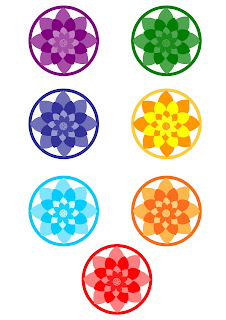By Faye Martins
In most cultures, people believe in a subtle life force that
lies beneath the mind, body, and spirit connection. In Yoga, this energy is
called “prana,” and it is centered in seven major chakras – or centers of
spinning energy – that start at the bottom of the spine and extend beyond the
crown of the head. These chakras, and the energetic pathways - or nadis -
between them, make up the subtle body.
Defining the Yogic Subtle Body
According to “Mosby’s Dictionary of Complementary and
Alternative Medicine,” Tibetan medicine defines the subtle body as “a network
of energy channels that transport energy derived from oxygen, sensory, and
food derived nutrients. This network lies parallel to the blood vessels and
nerves in the body; it facilitates and coordinates the movement of the flow of
blood and neural impulses. It is not an anatomical system, such as the
cardiovascular or nervous system and cannot be view conventionally. Instead, it
is accessed through practice of imagination and visualization that can be
accomplished through meditation.”
The Chakra System and Physical Anatomy
The chakra system overlaps the spine and roughly corresponds
to the endocrine system. Although it is not necessary to understand the chakras
in order to practice Yogic exercises, the knowledge can be helpful. Each chakra
symbolizes a specific part of the body; an energy blockage in any chakra can
affect physical, mental, and spiritual well-being related to that anatomical
area of the body.
The Seven Main Chakras
· The first, or root chakra, is found at the base of the
spine. It relates to survival, trust, and stability. Its Sanskrit name is Muladhara.
· The second, or sacral chakra, is related to pleasure,
creativity, and joy. Imbalances may lead to problems with emotions, boundaries,
hormones, or addictions. Its Sanskrit name is Svadhistana.
· The third chakra, or solar plexus, is the seat of personal
power and core vitality. When balanced, it represents spontaneity, purpose, and
vitality. Its Sanskrit name is Manipura.
· The fourth, or heart chakra, connects us to the universe and
symbolizes love and compassion, for self and for others. The Sanskrit name is
Anahata.
· The fifth, or throat chakra, represents communication,
creativity, and self-expression. Singing, chanting, writing, deep breathing, or
expressing feelings help keep this center flowing freely. In Sanskrit, it is
called Vissudhi.
· The sixth chakra, or the third eye, is linked to intuition,
perception, imagination, and clear sight. Poses, meditations and visualizations
help to balance the third eye, also called the Ajana in Sanskrit.
· The seventh chakra, or the crown chakra, is represented by a
lotus and correlates with connection to the higher self, universe, and God. It
is the center for awareness, bliss, and connection. In Sanskirt, the crown
chakra is called the Sahasrara.
The greater our awareness of the subtle body, the greater is
our ability to recognize and deal with energy blockages before they affect our general
well-being and happiness. Music, colors, poses, breathing exercises, and
meditation are just a few of the many ways to keep prana flowing freely through
our chakras.
© Copyright 2013 – Aura Wellness Center – Publications Division
To see find out more about yoga or see our selection of online yoga certification programs, please use the yoga resources on the right side of this page.
To see find out more about yoga or see our selection of online yoga certification programs, please use the yoga resources on the right side of this page.
If you are a teacher, yoga studio manager, blogger, e-zine, or website publisher, and are in need of quality content, please feel free to use my blog entries (articles). Please be sure to reprint each article, as is. Namaste!

